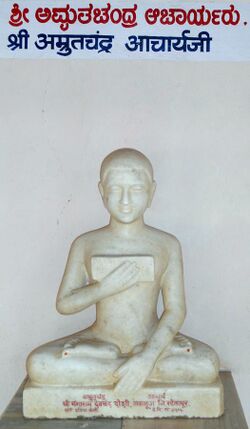Religion:Puruşārthasiddhyupāya
| Puruşārthasiddhyupāya | |
|---|---|
 Image of Acharya Amritchandra, author of Puruşārthasiddhyupāya | |
| Information | |
| Religion | Jainism |
| Author | Acharya Amritchandra |
| Period | 10th Century CE |
Puruşārthasiddhyupāya (Purushartha Siddhyupaya) is a major Jain text authored by Acharya Amritchandra.[1][2] Acharya Amritchandra was a Digambara Acharya who lived in the tenth century (Vikram Samvat). Puruşārthasiddhyupāya deals with the conduct of householder (sravak) in detail.[3] Another major Jain text that deals with householder's conduct is Ratnakaranda śrāvakācāra. Puruşārthasiddhyupāya also deals extensively with the Jain concept of ahiṃsā.[4]
Content
Like all Jain texts first sloka (aphorism) of Puruşārthasiddhyupāya is an invocation:
Victory to the Supreme Effulgence (Omniscience – the infinite and all-embracing knowledge) that images, as it were in a mirror, all substances and their infinite modes, extending through the past, the present, and the future.[5]
Ahimsa
Puruşārthasiddhyupāya deals extensively with the Jaina concept of ahimsa (non-injury) particularly in reference to its observance as a minor vow (anuvrata) by the Śrāvaka. In "Verse 43" deliberate himsa (injury) is defined as “acting under the influence of passions, an injury caused to physical or psychical vitalities” (verse 43).[6] Acharya Amritchandra then elaborates on the observances that help the householder in abiding by his minor vow of ahimsa. Eleven verses (79-89), cautions the householder regarding certain misconstrued notions that people put forward to justify their acts of himsa.[7]
See also
Notes
- ↑ Jain 2012, p. xiii.
- ↑ Finegan, Jack (1952-08-01). The archeology of world religions. Princeton University Press. p. 205. https://archive.org/details/in.gov.ignca.44705.
- ↑ Jain 2012, p. xiv.
- ↑ Duli C Jain (1 June 1997), Studies in Jainism, Jain Study Circle, p. 26, ISBN 9780962610523, https://books.google.com/books?id=cj2PZR_vsKkC&q=amritchandra
- ↑ Jain 2012, p. 1.
- ↑ Jain 2012, p. 33-34.
- ↑ Jain 2012, p. 55-60.
References
- Sain, Uggar; Sital Prasad (Brahmachari) (1931), The Sacred Books of the Jainas, https://books.google.com/books?id=CLEVAQAAIAAJ
- Jain, Vijay K. (2012), Acharya Amritchandra's Purushartha Siddhyupaya, Vikalp Printers, ISBN 9788190363945, https://books.google.com/books?id=4iyUu4Fc2-YC&pg=PR14
 |

